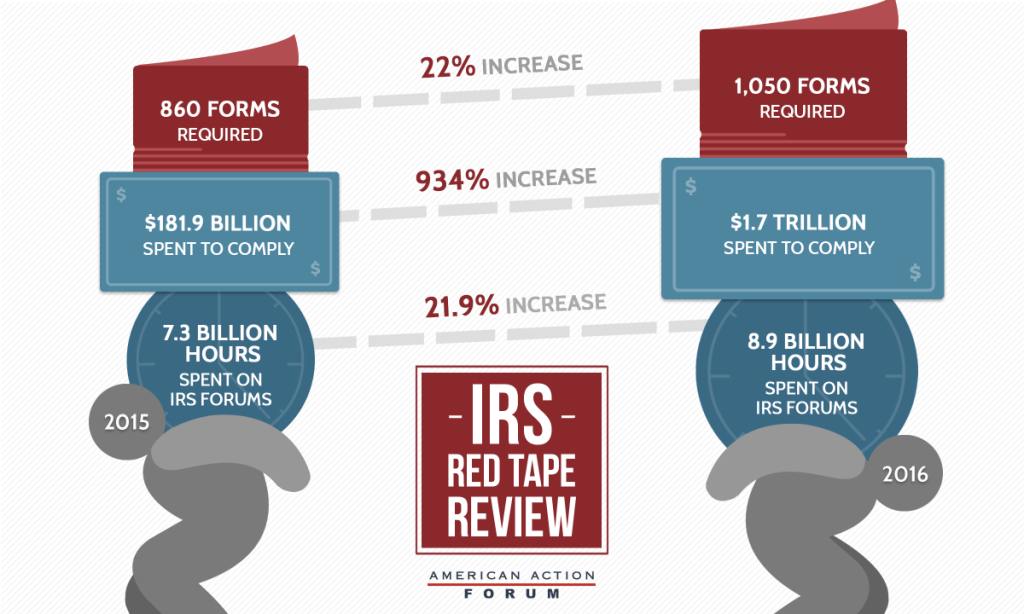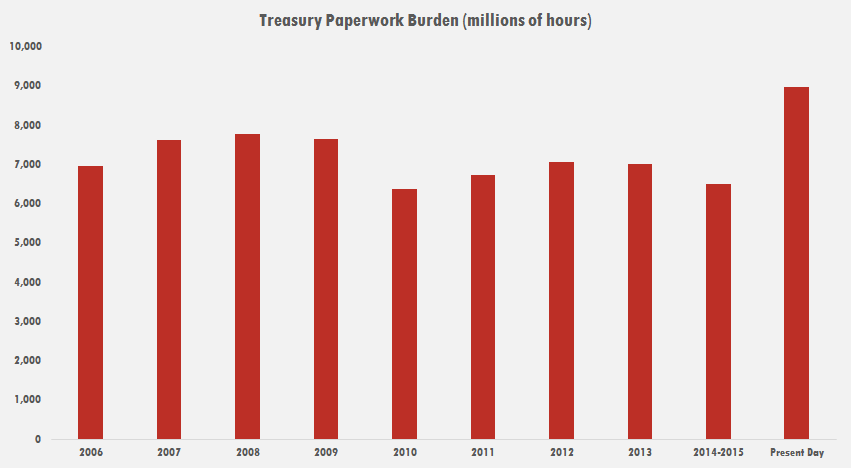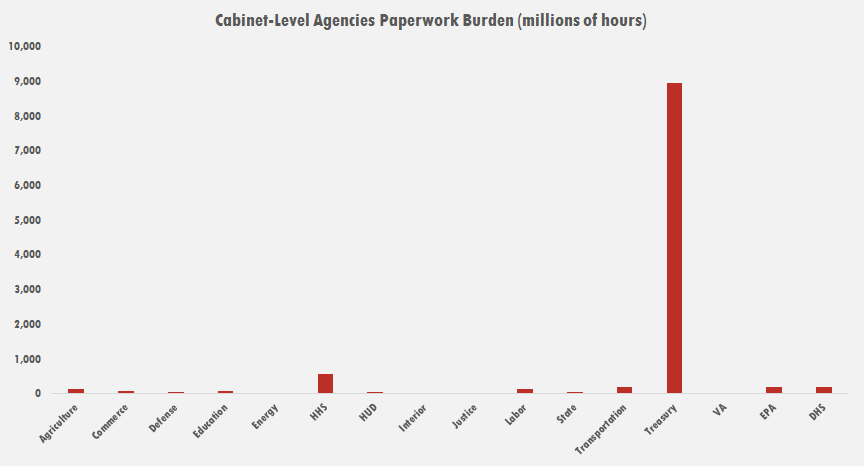Insight
April 14, 2016
Tax Day 2016: The Regulatory Side

The Obama Administration has set a record for Treasury Department paperwork, just in time for tax season. Americans will soon mark one of their least-liked days of the year: Tax Day. Beyond the part where taxpayers must hand over some of their money to the Treasury, there is plenty of stress surrounding the endless forms from the Internal Revenue Service (IRS). Unfortunately, for Tax Day 2016, taxpayers will spend a record amount of time and resources completing this inglorious task (according to the government’s own estimates).
IRS Red Tape Breakdown:
- Hours: 8.9 Billion
- Hours Per Paperwork Submission: 11.1
- Costs: $1.7 trillion
- Forms: 1,050
After a slight decrease from 2014 to 2015 (7.7 billion hours to 7.3 billion), the overall tally of paperwork burden hours in 2016 shot back up to nearly 9 billion hours. To put that in perspective, it would take 4.4 million Americans, working 2,000 hours annually to complete IRS’s paperwork. That’s roughly the population of Kentucky.
The primary reason for this dramatic shift comes in the form of one adjustment to the business income tax forms. At the end of 2015, IRS finalized an updated estimate of its Business Income Tax Return paperwork requirement, from 362 million to 2.8 billion hours. Although this adjustment was largely an exercise in updating a decades-old methodology, it still pushed Treasury’s overall paperwork burden to a record high.
The updated Business Income Tax Return paperwork estimate is also notable because it now outpaces the Individual Income Tax Return’s hourly burden by roughly 200 million hours. Curiously, IRS provides a dollar estimate to the individual return ($33.7 billion), yet fails to do so for the business return side. Using a rate of $33.26 per hour (the median wage of a regulatory compliance officer), the total compliance for business return red tape would exceed $93.1 billion in compliance costs. The intricacies of business tax liabilities likely command more robust and sophisticated accounting resources, so this rate is possibly a conservative estimate.
Beyond those two costly paperwork-intensive regulations, the next most time-consuming IRS requirements include:
|
Information Collection Requirement |
Annual Paperwork Burden (Hours) |
Costs |
Forms |
|
U.S. Income Tax Return for an S Corporation |
889,393,518 |
$28.1 Billion |
7 |
|
Form 4562 – Depreciation and Amortization |
448,368,447 |
$14.2 Billion |
1 |
|
Employer’s Quarterly Federal Tax Return |
388,256,964 |
$12.3 Billion |
14 |
|
U.S. Income Tax Return for Estates and Trusts |
375,796,476 |
$11.9 Billion |
7 |
|
Employer’s Annual Federal Unemployment (FUTA) Tax Return |
105,295,370 |
$3.3 Billion |
5 |
It is also important to note that, underneath each overarching “Information Collection Requirement” (ICR), there are generally multiple forms for the respondent to complete. As of this year, tax return filers, cumulatively, can expect to confront a total of 1,050 forms. This figure represents an increase of roughly 200 forms from past years. So not only will tax filings take more time, but taxpayers and their accountants will potentially need to keep track of more paper and electronic filings.
Treasury’s Outsized Burden
When discussing paperwork burdens, no other agency can rival the Department of Treasury. As the graph below reveals, Treasury imposes the vast majority of the federal government’s paperwork burden … and it’s not even close.
Even Health and Human Services (HHS) barely matches Treasury’s 8.9 billion hours. HHS, at more than 582 million hours, easily outpaces the Department of Transportation and the Environmental Protection Agency. For perspective, the federal government currently imposes 11.4 billion hours of cumulative annual paperwork. IRS alone is responsible for 78 percent of that total. In a broad sense, fundamental tax reform could provide substantial regulatory relief, at least through paperwork requirements.
Alternative Measures of Tax Compliance Costs
As noted by the Taxpayer Advocate Service (TAS), many entities have attempted to estimate the total cost of tax compliance and experts have embraced a range of methodologies.[1] The TAS, for example, estimated the cost of income tax compliance in 2010 at $168 billion. Inclusion of additional cost considerations and alternative approaches to monetizing hours spent in compliance alter these estimates considerably. For example, applying just the federal minimum wage ($7.25 per hour) to the hours that IRS did not monetize would reduce the total cost estimate made in this paper to $64.5 billion. Fichtner and Feldman completed a thorough assessment of the costs that the U.S. tax code extracts from the economy through complexity and inefficiency, beyond TAS’s estimate. According to the authors, in addition to time and money expended in compliance, foregone economic growth, and lobbying expenditures amount to hidden costs estimated to range from $215 billion to $987 billion. [2]
Other measurements beyond mere time and pecuniary estimates reflect an increasingly burdensome tax code. The TAS has reported that tax compliance is so onerous for individual taxpayers, 94 percent of individual taxpayers used a preparer or tax software to prepare their returns.[3] The tax code has become so onerous that the IRS struggles to administer it. According to the TAS, the IRS’s ability to answer taxpayer telephone calls and the IRS’s ability to respond to taxpayer correspondence offer key metrics for taxpayer service. According to the TAS, the IRS received over 100 million calls in fiscal year 2015. In 2015, the IRS was only able to answer 62 percent of calls received, compared to 87 percent in 2004. The IRS failed to respond in a timely manner to 50 percent of taxpayer letters received in 2012, compared to 12 percent in 2004. This worsening response rate comes despite the increasing use of preparers and software by individual taxpayers.
Conclusion
8.9 billion hours of IRS paperwork is enough to force every person in the nation to spend 27.5 hours a year filling out forms. That’s more than one million years of paperwork and accounting compliance to complete the task of paying taxes. This is a sobering figure, but taxpayers can take little solace in the knowledge that this amount continues to climb, as does the expense, and number of forms taxpayers must navigate. Fundamental tax reform might be difficult, but compared to the status quo, anything is easier.
[1] “The Complexity of the Tax Code.” Taxpayeradvocate.irs.gov. Internal Revenue Service Web. http://www.taxpayeradvocate.irs.gov/2012-Annual-Report/downloads/Most-Serious-Problems-Tax-Code-Complexity.pdf
[2] Fichtner, Jason J. and Jacob M. Feldman, “The Hidden Costs Of Tax Compliance.” Mercatus Center 2015 Web. http://mercatus.org/sites/default/files/Fichtner-Hidden-Cost-ch1-web.pdf
[3] “Annual Report to Congress.” Taxpayeradvocate.irs.gov. Internal Revenue Service Web. http://www.taxpayeradvocate.irs.gov/Media/Default/Documents/2015ARC/ARC15_Volume1.pdf














